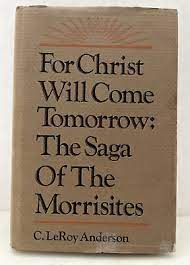Articles/Essays – Volume 16, No. 4
Career of a Counter-Prophet | C. LeRoy Anderson, For Christ Will Come Tomorrow: The Saga of The Morrisites
This handsome volume immediately establishes itself as the definitive work on the Morrisite movement within Mormonism. A complete study of Joseph Morris and his followers has long been needed and LeRoy Anderson has filled the void. After a decade of research, travel, and writing, Anderson has produced an interesting volume that details the splinter movement from its inception in Utah to the Morrisites’ demise in diverse locations of Mon tana, Washington, and California.
Joseph Morris considered himself a prophet much like Joseph Smith. In migrating to Utah, he had not discovered Zion to be perfect nor compassionate. After con verting to Mormonism in England and finally making his way to Utah, Morris’s life became confused during the Mormon reformation of the mid-1850s. Frustrated in love and religion, Morris began to view himself as a special individual with a very special call. In a series of letters, he begged Brigham Young to counsel with him and share aspects of leadership in the earthly kingdom. Young continually dismissed Morris as a crazed apostate, refusing to meet him and discuss his new revelations. Ultimately Morris and his followers, all ex-Mormons, became an obnoxious irritant to the Mormon majority and were driven from their midst.
Most of the book discusses Joseph Morris and his activities within the LDS Church and the events that lead to his founding an organization that challenged the authority of Brigham Young in Weber and Davis counties. Anderson carefully documents the altercation between the Morrisites and the posse or militia representing the civil authority in that part of Utah territory. The tragic outcome in June 1862 when Morris and some of his followers were killed near the mouth of Weber Canyon lays open an unfortunate reality about the inability of majority religious groups to tolerate dissension in their ranks.
Anderson did excellent work in analyzing Morris and his desire to commune with diety. The book compassionately discusses how and why people became fanatics as external pressures and internal tensions be came unbearable. The tragedy of the Morrisite saga is that humans apparently learn little from experience. Although the Mormon people were driven from state to state and revered their prophet as a martyr, they had little empathy for those who left the faith and sought diety elsewhere. These dissenters were treated as harshly as were those Mormons forced from Missouri or Illinois.
The author’s objectivity will cause some grief among readers. Anderson is careful to not editorialize and those who demand faith-promoting history will be dismayed by the author’s unwillingness to dis miss Morris as a lunatic whose misguided followers deserved their fate. On the other hand, those highly critical of the Mormon experience will be upset by Anderson’s un willingness to place blame on the LDS Church hierarchy per se. Individuals were responsible for an unfortunate historical event, and those people are the essential ingredients of the story.
Anderson relies heavily on the written revelations of Joseph Morris. At times, the quotations are too long and much of the material contained in the quotations is irrelevant to the story. In fact, this reviewer found the extensive quotes distracting and felt judicious paraphrasing would have been more effective. The enticing discussion of the post-Utah Morrisites contains previously unused material, but the chapters are a bit disjointed and lack direct connections to Morris himself.
This volume makes an important contribution to understanding the human experience. Throughout history varieties of religious millennialist movements have existed. To learn why people are attracted to such groups is significant. The Morrisites were always numerically small; however, because of Anderson’s fine work, they will no longer be historically obscure.
For Christ Will Come Tomorrow: The Saga of the Morrisites by C. LeRoy Anderson (Logan, Utah: Utah State University Press, 1982), 252 pp., bibliography, index, $12.90.


 Back to full Issue
Back to full Issue

